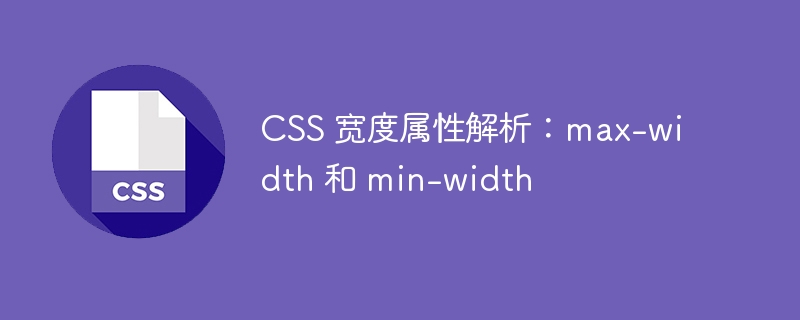

CSS width attribute analysis: max-width and min-width, specific code examples are required
Introduction:
In web design, the width of the control element is very important. CSS provides a variety of ways to set the width of elements, of which max-width and min-width are two commonly used properties. By controlling the maximum and minimum width of elements, we can achieve adaptive and responsive layout effects. This article will introduce the usage of max-width and min-width in detail and give specific code examples.
1. Usage of max-width:
The max-width attribute is used to set the maximum width of an element. When the element content exceeds the maximum width, the browser will automatically shrink it to ensure that the element does not exceed the set maximum width.
Syntax:
选择器{ max-width: value; }
value can be a specific pixel value (px), percentage (%) or relative unit (em, rem), etc.
Example 1: Use max-width to set the image width
Suppose there is an image that needs to be displayed in a container, but the original size of the image is too large. We hope that when the container width is not enough to accommodate the image, it will automatically Shrink the image width to the maximum width of the container.
HTML code:
CSS code:
.container{ max-width: 400px; margin: 0 auto; } .container img{ max-width: 100%; height: auto; }
In the above code, the maximum width of the container is 400px. The image uses max-width: 100% to set its maximum width to the width of the container (ie 400px). When the container width is greater than 400px, the image will be displayed according to its original size. But when the container width is less than 400px, the image will automatically shrink to the maximum width of the container.
2. Usage of min-width:
The min-width attribute is used to set the minimum width of an element. When the element content is small and the width is less than the minimum width, the browser will automatically stretch the element to ensure that the element will not be smaller than the set minimum width.
Syntax:
选择器{ min-width: value; }
value can be a specific pixel value (px), percentage (%) or relative unit (em, rem), etc.
Example 2: Using min-width to implement adaptive layout
Assume that you need to implement an adaptive layout. The width of the container should change as the browser window size changes, but should not be less than a minimum value. .
HTML code:
自适应布局示例
这是一个段落内容,用于示例自适应布局。
CSS code:
.container{ min-width: 300px; max-width: 800px; margin: 0 auto; }
In the above code, the minimum width of the container is 300px and the maximum width is 800px. When the browser window width is greater than 800px, the container width will remain at 800px. When the browser window width is less than 300px, the container width will automatically expand to 300px.
Conclusion:
By using the max-width and min-width attributes, we can easily achieve adaptive and responsive layout effects. max-width is used to set the maximum width of an element. When the content exceeds the maximum width, the browser will automatically reduce its width. Min-width is used to set the minimum width of the element. When the content is less than the minimum width, the browser will automatically stretch the width of the element. The flexible use of these two attributes can help us achieve elegant page layout and improve user experience.
The above is the usage analysis of CSS width attributes max-width and min-width. I hope it will be helpful to you.
The above is the detailed content of CSS width attribute analysis: max-width and min-width. For more information, please follow other related articles on the PHP Chinese website!




